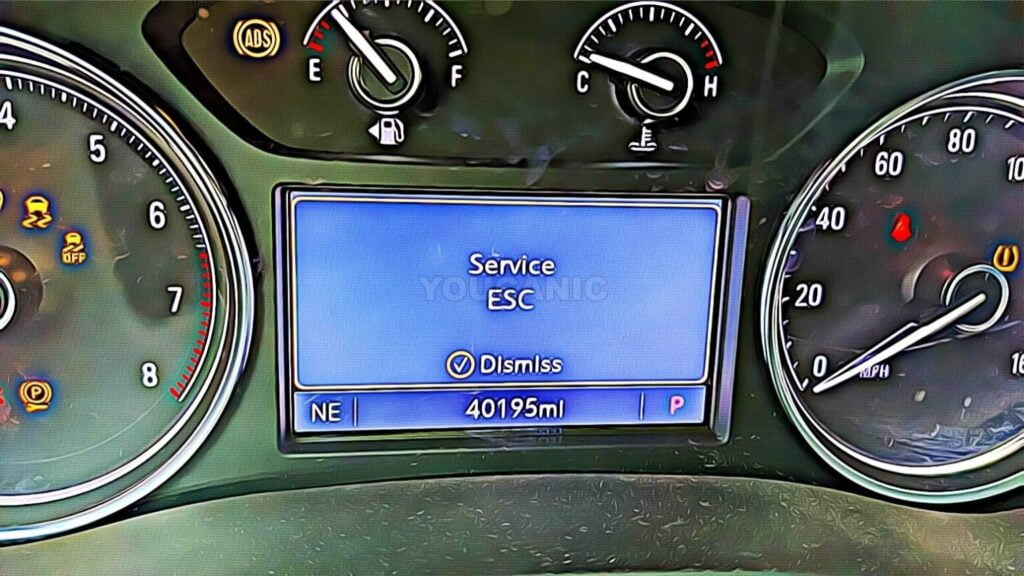In today’s modern vehicles, we’re surrounded by a symphony of lights and warnings, all there to keep us informed about our car’s health. One of the unsung heroes in this automotive orchestra is Electronic Stability Control (ESC).
It’s like a guardian angel, silently watching over your safety. ESC uses fancy sensors to eavesdrop on your driving intentions and the actual dance of your wheels. If it senses a rebellion, it steps in, gently tapping the brakes and whispering to the engine to bring things back in line.
However, even guardian angels can have a bad day. ESC may hiccup due to sensor glitches, software bugs, or even grumpy control modules. When that little electronic stability control light blinks on your dashboard, it’s not trying to ruin your day.
It’s sending you a message, saying, “Hey, something’s not quite right here.” But don’t fret. In this journey, we’ll explore why this light might be acting up and what you can do to get your car back to its peak performance.
Let’s dive in!
How Electronic Stability Control Works
Electronic stability control (ESC) operates by carefully managing your car’s engine power and the brakes on each wheel. Much like other helpful co-pilots, ESC springs to life when you start your vehicle. It’s like a silent guardian, always in the background, quietly observing your steering wheel movements and keeping tabs on the speed of each wheel.
When the watchful sensors detect that you might be losing control of your car, ESC springs into action. It works its magic to correct oversteer (when you’re turning too much) or understeer (when you’re not turning enough). How? By gently tapping the brakes on individual wheels, nudging your car back onto its intended path. If you accidentally give it too much gas, ESC even talks to the engine, asking it to calm down.
All these careful adjustments have a fantastic side effect – they significantly reduce the chances of your car doing an unplanned somersault. Instead, your trusty vehicle stays on the road, away from potential tripping hazards on the roadside. ESC can cleverly increase brake pressure on one side of the car, coaxing it to steer gently in that direction. The results depend on whether it’s the front or rear brakes dancing, and they may vary.
ESC doesn’t slam on the brakes or jerk the steering wheel automatically. It’s more like a ballet, gracefully guiding your car back in line with the direction you want to go. And in those moments when things get too wild, ESC might have a chat with the engine and ask it to slow down the whole show. It’s all about keeping you safe and in control.
Common Issues with Electronic Stability Control
Before we dive into how to fix these issues, let’s explore some common problems you might encounter with your car’s Electronic Stability Control (ESC):
- Warning Light Illumination: The ESC warning light on your dashboard is the clearest sign that something’s amiss. It’s like the system’s cry for help, indicating a problem that needs your attention.
- Reduced Stability: If your car feels less stable, especially during quick turns or on slippery roads, a malfunctioning ESC might be to blame.
- Strange Sounds: Sometimes, when you engage the ESC system, you might hear odd noises like grinding or clicking. These sounds could signal a mechanical issue within the system.
- Power Loss: In some cases, ESC problems can lead to a noticeable drop in engine power.
- Brake System Woes: If your anti-lock braking system is on the fritz, with issues like worn brake linings or air and dirt in the brake fluid, it can mess with how ESC works.
- Tire Troubles: ESC isn’t a miracle worker if your tires are in bad shape, especially if they have poor tread or are generally in poor condition. For a deep dive into tires, check out our tire guide.
- The Pesky Brake Light Switch: Sometimes, a faulty brake light switch can play tricks on your ESC system, making that ESC light flicker. The fix? A straightforward and affordable replacement switch.
- High-Performance Quirks: When you’re pushing your car to its limits with high-performance driving, your steering input might not always align with the car’s actual path. In these cases, ESC might jump in when you’d rather it didn’t.
How To Fix Service Electronic Stability Control
Now, let’s roll up our sleeves and explore how to tackle these ESC challenges:
1. Check for Error Codes: When that ESC warning light flashes, the first step is to have your car’s computer scanned for error codes. This diagnostic tool will pinpoint the exact issue troubling your ESC system.
2. Inspect Wheel Speed Sensors: Wheel speed sensors often cause trouble in the ESC system. Look for any contamination or damage and replace them if necessary.
3. Examine Connectors and Wiring: Give the connectors and wiring related to the ESC system a thorough check. Problems may arise from faulty cables or loose connections. If you spot any issues, reconnect or replace them.
4. Brake System Checkup: The ESC system relies on your brakes, so it’s crucial to ensure they’re in good shape. Replace worn brake pads and rotors as needed.
5. Yaw Sensor Calibration: In some cases, recalibrating the yaw sensor can resolve ESC problems. It’s best to have a skilled mechanic perform this using specialized tools.
6. Professional Diagnostics: If the issue persists after these checks, it’s wise to seek professional diagnostics and repairs. Complex ESC problems may require specialized equipment and expertise.
Remember, while some issues can be tackled by car owners, more complicated problems might call for a professional’s touch.
Your car’s safety and stability are worth the effort!






